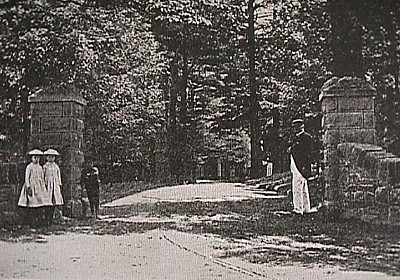2006.12.29
Ury House
Ury House is situated upon the Pine Road, on the hill crest of the divide between the Pennypack and the Tacony Creek waters. This venerable mansion, antedating Penn's time, surrounded by an estate of one hundred acres, was purchased by Miers Fisher from the Taylor family at the close of the War of Independence.
Originally a fort built by Swedish Refugees in 1645, it was enlarged both by the Taylors and Miers Fisher, who bought the place in 1790. The great antiquity of this mansion is shown by its construction and architecture. Two old chimney back plates of iron, one ornamented with the English coat-of-arms and the legend "Dieu et mon Droit," and the other with a plain scrool bearing the date of 1728 are objects of interest to the antiquarian, The latter plate was not taken from the oldest part of the mansion. A plate similar to this is in Gorvernor Keith's house.

The approach to Ury House is by a broad avenue four hundred feet in length, of venerable pines upward of one hundred years of age. The visitor enters through a pillared porch and broad low hall with heavy rafters, which is heated by a large open fireplace surmounted by a mantle of antique design.
There remained a square stone tower, built, as has been testified by comparison, of stone quarried close by. This tower consisted of a curious cellar, approached by solid stone steps leading to a door of wrought iron, supported on either side by tremendous stone drillings. Over the cellar was a square room, from which a steep stairway led to another, and over it, with sloping roofs and reached by a very rickety ladder, was a garret.
It is supposed that this tower was built by those Swedes who sailed up the Pennypack, and was used as a sort of fort and government house, the people living in huts scattered about in the forest, and only coming into the fort in case of an attack from neighboring Indians.
George Washington is said to have dined in the old hall.
Miers Fisher gave Ury its name, from the country-seat of Barclay, the famous Scotch Friend and the author of The Apology--"Urie" or "Uri," in Scotland.
About ninety years ago [1802] Mr. Fisher was visited by the daughter of an eminent minister. She thus described her drive from Philadelphia: "We drove through forests from Spring Garden Street to Fox Chase, which consisted of a log tavern with an English sign, on which was painted a picture of mounted huntsmen in red coats, and Nathan Hicks, the proprietor, holding up the foxes that the hounds had killed."
Mr. Miller, who bought "Ury" in 1800 [sic-- Miers Fisher owned Ury House until at least 1818], is said to have planted the avenue of pine trees.
Mr. West became owner of "Ury" eight years later [sic], and finally in 1842 Mr. Stephen R. Crawford bought "Ury" of Dr. D. R. Holmes.
In the following year "they" were visited by a queer old woman, who arrived in a very old-fashoned chaise. She said she was ninety years old and a grand-daughter of the Mr. Taylor whose name first appeared on "Ury's" title-deeds. She had come to drink a cup of tea in the old Swede Hall, where she was born. This old woman told Mrs. Crawford that when she was a little girl ten years old [1763], Ury was the center of an immense peach-orchard, with cows feeding up to the very doors of thehouse.
The mansion is surrounded by spacious lawns and a grove of noble trees of great girth and towering height; while an old-fashioned garden, with its numerous beds bordered by boxwood hedges, is most attractive.
Mrs. Jane Crawford, whose name is so intimately associated with Ury House, and whom many who read this article will recall with loving and grateful remembrance, was born in Edinburgh, Scotland, and came to this country in 1841. After her husband's financial reverses and death in 1863, Mrs. Crawford devoted her life to the instruction of youth, and Ury House became an institution of education, at which many of our leading men received the careful training which fitted them for their future responsibilities.
Mrs. Crawford's rare intellectual attainments, her great executive ability, her refinement and charming grace of manner eminently fitted her for her position as the head of a large and prosperous school. Only those who knew her well can appreciate the beauty of her character, the gentle firmness and loving care with which see guided those under her instruction. After a successful exiatence of twenty-one years, Mrs. Crawford gave up her school, and Ury House passed into the hands of her son, Mr. Joseph U. Crawford, an officier in the Pennsylvania Railroad, who now occupies as a private residence the old mansion in which he was born.
Rev. S. F. Hotchkin, M.A., The York Road, Old and New (Philadelphia: Binder & Kelly, Publishers, 1892), pp. 406-10.
|